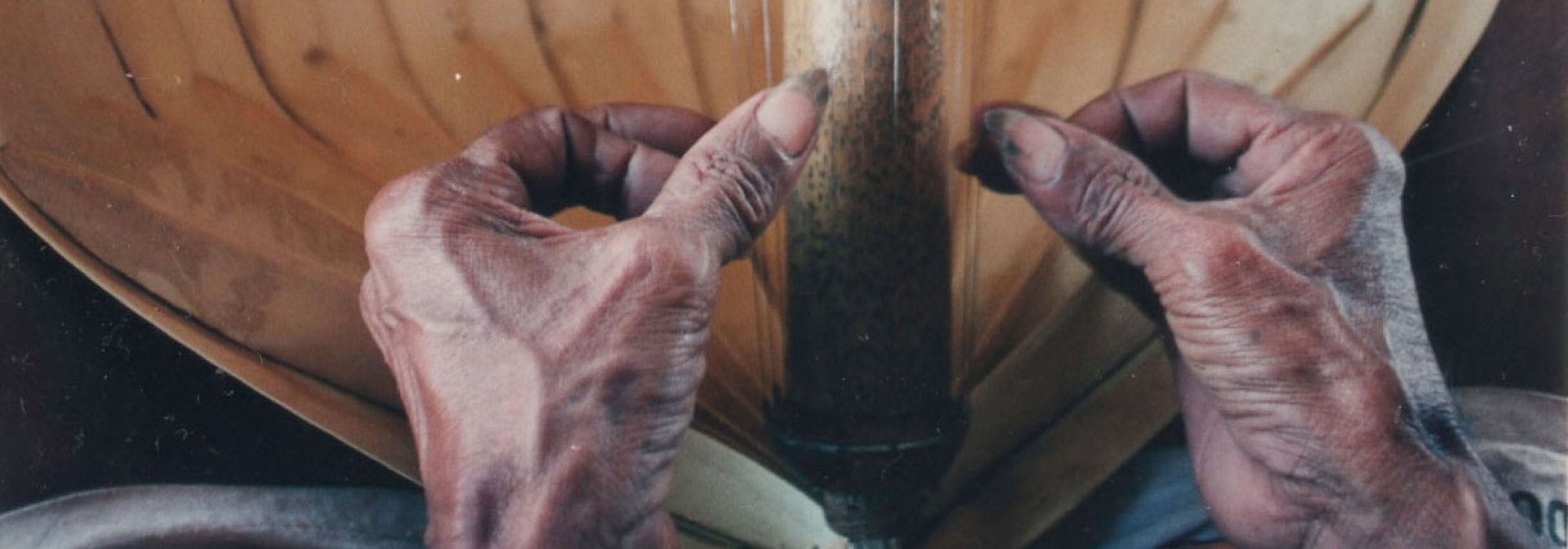Performing Rotinese
Sasandu-Accompanied Song
Abstract
Sasandu-accompanied song is performed at festive gatherings and traditional celebrations of transition on the island of Roti. While the strictly musical elements of a performance, such as the song’s instrumental accompaniment, rhythm, and melody, are drawn from recognized, traditional forms, the sung texts are largely improvised. A singer’s skill is judged by his ability to use bini, a poetic register of Rotinese language that is based on a canon of paired, parallel terms. An older form of Rotinese sasandu-accompanied song comprised entirely of bini is now rarely heard. Most songs are composed of verses in bini-couplet form alternating with refrains in bahasa Kupang, the local, regional dialect of Malay. Some innovative performers have created new songs that incorporate wordplay and explore idiosyncratic themes. The importance of the sasandu as a Rotinese cultural symbol and vehicle of expression is celebrated in Rotinese oral narratives.
Performing Sasandu
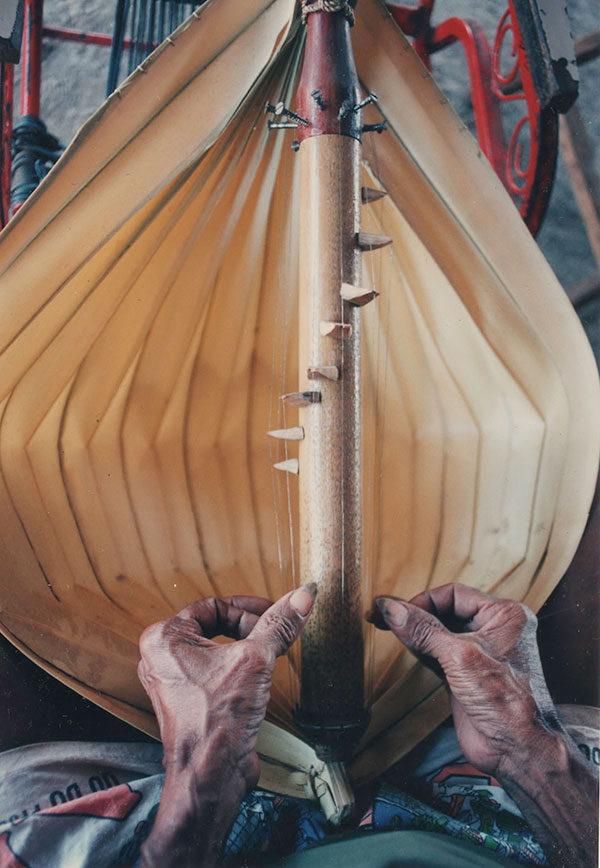
The small, dry, hot island of Roti is in southernmost Indonesia, located just southwest of Timor in the province of Nusa Tenggara Timur(Eastern Southeastern Islands). Performances of traditional Rotinese music, dance, and oration happen at festivals and at parties for important events, such as a birth, the dedication of a new house, a wedding, or a wake. These performances include kebalai, a circle dance with call-and-response singing, meko gong-and-drum music, and Rotinese song accompanied by sasandu, a bamboo tube zither with ten or eleven metal strings mounted in a palm-leaf shell.
At a festive occasion, the main music-making goes on in the cool of the evening as people converse, play cards, smoke homegrown tobacco or kretek clove cigarettes, drink sweet, strong coffee, and eat boiled water-buffalo hide with sea salt and other treats. Many guests also enjoy betel and areca (sirih pinang), and some will drink moderate amounts of potent, homemade palm gin (sope).Meko gong pieces are played spontaneously throughout the evening. They start when someone, usually an older man, picks up a pair of meko, most often the leko pair, and beats out the pattern to a well-known composition. One by one other meko players join him, with the labu drummer adding the counter rhythm (fig. 1 and video 1). Depending on the piece performed, two or three women dance and wave their ikat shawls gracefully, or men energetically perform fofoti (a kind of warrior dance) with whoops and yells.
Video 1. Busalanga Iron Meko Gong Group in Roti, Indonesia
Someone will certainly be encouraged to sing and play sasandu during the evening. Most sasandu players also play meko and labu. One, or even two or three of the retiring meko players might pick up sasandu and commence tuning and playing, so the continuum of music at the party is unbroken. Easily and cheaply made of palm leaf, bamboo, and a bit of wood and wire, a sasandu can usually be found for any player who wants to join in but is not carrying his own instrument. I say “his” own instrument because, like meko and labu, performing sasandu-accompanied songs is a skill of men and often older men. According to Rotinese custom, women do not play sasandu or take the lead in singing with it, although in practice some women like to sing along.
When a song performance commences and the sasandu has established a pattern, usually a two- or four-beat figure with variations or the thirty-two-beat form of “Lelongek/Lelendo,” the vocalist enters either with a verse in couplet or with a fixed refrain, depending on the piece and his mood. Others join in the verses, singing the second half of the bini couplets they recognize and during the refrain. One or more persons sitting near the sasandu player will accompany him by drumming sharply, in the style of labu drumming in the meko ensemble, on the instrument’s hard leaf shell with any light stick that lies at hand. If a singer pauses, a second or third singer sometimes initiates couplets and takes over leading the song. Although Rotinese song performers are soloists in the sense that a single person often plays the sasandu accompaniment, sings or improvises the text, and arranges the song, a creative public performance can be social and participatory, with anyone joining in by singing, clapping, and drumming on the sasandu’s leaf shell. If the mood is right, this generates an atmosphere in which open-ended performances of sasandu-accompanied song rise and fall naturally like waves, as everyone is carried away by the power of the song and its rhythmic, poetic sway.
Inside Sasandu
The sasandu is sometimes called sasandu meko or sasandu gong to distinguish it from the diatonic sasando biola, an expanded version of the sasandu that was invented in the early part of the twentieth-century to play Dutch and other non-Rotinese music. While it varies from player to player, the sasandu’s typical pentatonic tuning (approximating G B C E F, although the actual starting pitch varies, with B and E often approximately 1/2 flat) is based, in theory at least, on the model of the meko gongs. In practice, each sasandu sounds slightly different due to variations in tuning and the way each instrument is made individually within a range of sizes, depending on the dimensions of the palm leaf used. Variations in tonality and color of each sasanduresult in a more or less unique harmonic setting for each performance. Indeed, one of the most important defining characteristics of Rotinese song is that it is an improvised or at least semi-improvised art form. As with tuning, each performer also improvises and interprets melody, text, rhythm, tempo, and form, depending on his expressive style.

The sasandu’s distinctive leaf-bucket resonator is made by shaping the large fan leaf of the lontar palm into a pleated hemisphere called a haik (fig. 2). The other main use of the Rotinese haik is to gather and carry tua lontar palm juice. Some Rotinese have observed that this use is reflected musically and symbolically in the way the sasandu’s haik “gathers” and “carries” the instrument’s sound. While it resembles tube zithers found among other Austronesian peoples—most nearly the Savunese ketadu haba, which also has a palm-leaf resonator—the Rotinese claim the sasandu as their own invention, and they revere it as the single most distinctive medium and symbol of their music culture.
Solo pieces for sasandu accompany basili martial arts and the dance-like martial display called foti. To accompany songs in an A:B form, pieces such as “Lelongek” and “Tae Benu” or repeating patterns associated with and named for well-known songs, among them “Teo Renda” and “Batu Matia,” are played. The relatively quiet and introspective sasandu weaves a rhythmic, harp-like texture to support the sung parallel couplets. Sharp, percussive tapping on the instrument’s dry palm-leaf shell augments the singing. Plucked string and voice combine to complement the couplets and wordplay. They create an appealing sound that is sometimes a bit rough and idiosyncratically tuned but always engaging. Most sasandu-accompanied songs alternate verses in bini poetic language with a refrain in standard Rotinese or bahasa Kupang. This regional lingua franca is a variation of Malay that includes Dutch, Rotinese, and Timorese elements. The texture and momentum of the sasandu provides the complementary setting for the sung text, which is often melancholy and wise but can also be humorous and ribald. A talented sasandu player who sings can improvise verses based on traditional couplets that suit the mood of the occasion. He can move listeners to tears or make them laugh with his sung poetry. While each song is identifiable by its distinctive refrain, sasandu part, and melody, the verses vary. Singers may use the same couplets in ritual language in different songs, provided the mood and meaning are appropriate for the song and the occasion for which it is being performed. An older sasandu-accompanied song style without refrains and composed entirely of couplets in ritual language is rarely heard these days.
Distinctly Rotinese
I first attended a performance of sasandu-accompanied song in Roti in 1992. Musicians from across the island had gathered in Termanu in central Roti for a government-sponsored Arts and Sports Festival, and they were playing informally before their official, amplified, onstage performance later that evening. In keeping with the festive occasion, the musicians were bedecked in elaborate handwoven tenun ikat cloth, and most were wearing ti’ilangga plaited palm-leaf hats. As they sang and played their sasandus, the air filled with the instruments sharply plucked sound.
The mood of most Rotinese songs is one of gentle melancholy and resignation. It conveys the traditional Rotinese worldview that life is full of suffering, is governed by fate, and is ultimately illusory. The songs aim to impart and reaffirm traditional wisdom and to arouse sentiments that are perceived to be distinctly Rotinese. At many musical gatherings I witnessed an old Rotinese listener shaking his head and sighing with real feeling at a sung couplet that he had no doubt heard innumerable times during the course of his long life. This response seemed to me like nothing less than an affirmation of faith by a believer who was acknowledging a creed that was for him both changeless and always new. To put it another way, as one Rotinese musician said when he observed that I had finally grasped some of the basics of constructing sung verses in ritual language, “Now when you sing, you can make Rotinese people cry!”
Most Rotinese singers draw almost exclusively on a well-known repertoire of traditional songs, such as “Batu Matia” (Heavy Rock), which describes the plight of a Sisyphus-like figure.
Roso roso non doi doso batu matia, batu matia tian natun telu
Dragging and pulling a heavy rock, a heavy rock the weight of three hundred
As a singer performs “Batu Matia,” he alternates the song’s refrain in bahasa Kupang (the regional version of Malay) with verses based on couplets in Rotinese bini ritual language, freely incorporating repetition of words and phrases withinterjections. Traditional oration in Roti finds its most sophisticated expression in bini, a poetic register of Rotinese that employs canonical parallelism. Ritual, poetic languages in parallel form are found throughout Eastern Indonesia (Fox 1974). These language forms express and encode social wisdom and significant ritual knowledge that depict reality as being fundamentally dualistic, in a syntactical form that is itself pervasively diadic. For example, the Rotinese bini couplet Hata hori au masik, oe dae ana noe (Man is like salt, touched by water he dissolves) metaphorically expresses the dualistic nature of the human condition, which seems solid and enduring even though it is fragile and ephemeral, in bini form using canonically paired terms hatahori:oe (man:water). Rotinese song texts are based on these sorts of parallel couplets, and a singer’s talent is judged primarily on his knowledge of bini and his skill in using it. Some other examples of bini couplets employed for sung verses in sasandu-accompanied song are Tasi nbesi neu ein, nale tasik bali de (When you are in deep water, the will of the sea prevails), Biti boak manu tolak, dae dusi basa sira (Even a shapely leg is ultimately dust), and Anak mak ndule dae, ina falu ndule oe (Orphans and widows are everywhere).
Video 2. “Batu Matia” performed by A. A. Malelak in Roti, Indonesia
With its timeless imagery and symbolism, “Batu Matia” typifies most Rotinese songs (video 2). Since the Second World War, however, new songs have been composed that describe a changing Rotinese society and are sometimes connected with specific historical events. “Ofalanga” (The Little Boat), the best-known song of this type, describes the plight of the Rotinese population that was taken captive as slave labor during the Japanese occupation, while “Tele Non Tel Ote Non” (Bend and Whisper), another song from the same period, addresses the breakdown of a traditional marriage negotiation.
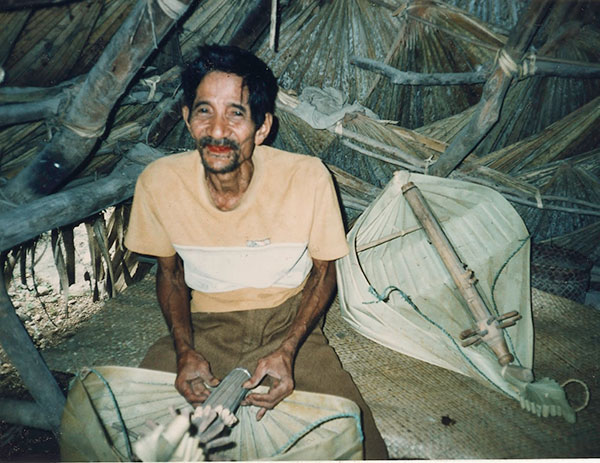
Some contemporary Rotinese musicians incorporate wordplay into performances of traditional songs, seemingly not for any narrative purpose but out of sheer delight with the sound and color of language itself. For example, in one performance I attended, an elderly, respected musician named Bernadus Henuk shocked and confused some of the listeners by incorporating a strange, double-time chant into the middle of an otherwise perfectly traditional rendering of “Batu Matia” (fig. 3). This interjection was a sort of surrealist limerick about a woman who was too embarrassed to go to town because of her poor clothes. Henuk then proceeded to describe, among other things, two ducks eating rose blossoms. When I asked him why he had made such a bizarre addition to the song, he smiled and replied, “Because I want to surprise people and make them say, ‘Wah!’”
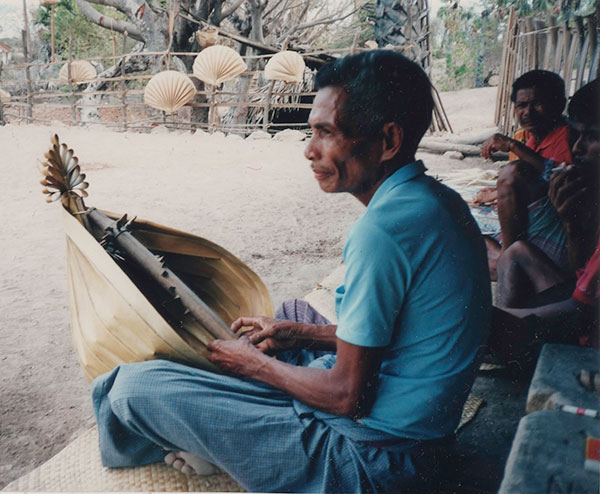
One of the most idiosyncratic sasandu-accompanied songs I heard performed in Roti was “Baku Natia,” a takeoff on “Batu Matia.” It was composed by Daniel Huan, a musician who lived on a rocky, wind-swept peak overlooking Roti’s southern coast (fig. 4 and video 3). “Baku Natia” is filled with local references, in-jokes, puns, and parody, and much of its imagery is difficult to fathom, even for Rotinese listeners. The title means “enough already” in Helong, a language spoken on the nearby island of Semau. Instead of struggling with “a heavy rock the weight of three hundred,” as in “Batu Matia,” the protagonist in “Baku Natia” struggles with the weight of his remorse. He regrets that he cannot marry the woman he loves because he does not have enough money to satisfy her family’s voracious demands for a bridewealth payment. He insists that his offer is “enough already,” but they demand three hundred. (As in “Batu Matia,” three hundred of what exactly is not specified, but it is presumably three hundred weights of gold.) He replies sarcastically that evidence of true feeling, like gold, must always be weighed carefully.
Video 3. “Feto Bo’I” performed by Daniel Huan in Roti, Indonesia
Each of the verses in “Baku Natia” presents from various points of view a bluesy image of the performer’s feelings of loss and regret. Feeling like a small boat lost on a troubled sea, he wonders where peace and tranquility can be found. He is also frustrated to discover that he is out of tobacco and has no money to buy more. Finally—and it is impossible to tell if this is meant to be taken as straight narrative, metaphor, or just an outburst of paranoia—he describes how his betrothed becomes a mistress to a rich foreigner.
A Symbol of Rotinese Identity
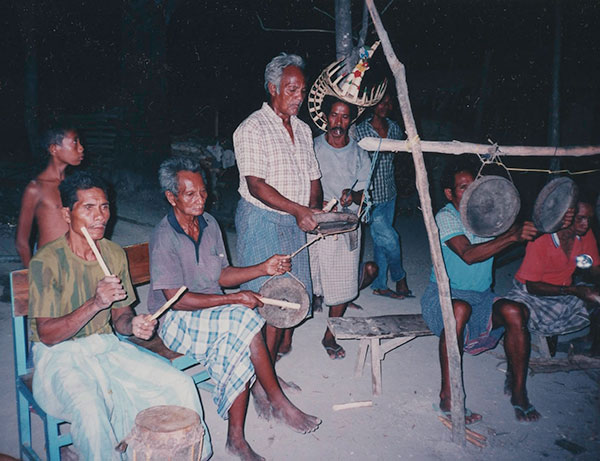
A vital Rotinese cultural object, the sasandu is cherished as the most prominent symbol and medium of Rotinese identity, yet an individual instrument is afforded little respect as a material object. I experienced this after the first performance of sasandu-accompanied song that I attended and recorded in Roti (fig. 5). The musicians had finished playing and were listening with a contented air to the playback from the tape. Around their feet the sasandus lay in the dust, bumped by every scrounging dog and splashed by the gobs of blood-red betel juice spit by adults. To add insult to injury, one musician casually flicked the ashes from a kretek clove cigarette into his sasandu, using it as an ashtray. This did not fit my expectation of how a “prominent symbol and medium of Rotinese identity” would be treated. In fact, I could not think of another society where serious musical instruments were treated quite so cavalierly. I later asked one of the musicians about it. He shrugged and said, “No big deal. When the sasandu wears out, we make another.”
During my stay in Roti I witnessed many such paradoxical examples of how the Rotinese seemingly accord little value to the sasandu, and I learned no ceremonies or displays indicate the instrument’s central role in Rotinese culture. Instead, the sasandu’s significance is expressed through the various oral traditions that are maintained on the island. This is in keeping with the overall modality of Rotinese culture, in which verbal skill and the ability to manipulate language properly are valued highly. Fox has described the primarily verbal orientation of the Rotinese as a tradition of oration (as opposed to traditions of ostension, which mainly employ visual signs) and suggests oration itself constitutes ritual on Roti (Fox 1979:146–50). Thus, the Rotinese affirm the sasandu’s importance not through displays or actions that can be observed, but through poetic images and mythological tales that must be heard, deciphered, and ultimately understood.
Rotinese mythological tales associate the sasandu with the polar forces of rejoicing and mourning, the natural and the supernatural, and life and death. One oral, poetic narrative describes how a man is so bewitched by malevolent spirits that he sprouts a “monkey’s tail and swine’s hooves” and loses his humanity. The sound of the sasandu finally draws him back from the realm of beasts to the world of men. Another tale traces the sasandu’s origins to the “first wedding” between the Clan of the Heavens and the Clan of the Seas. The Rotinese attribute the origins of exogamy, cooked food, and other fundamental aspects of culture to this primal union. The sasandu music at the first wedding ceremony takes the place of the negotiation and payment of bridewealth. This, it is said, results in the first marriage celebration being an especially joyous one.
Another mythological narrative pairs the origin of the sasandu with the origins of death and mourning. In this tale, the Rotinese try everything to assuage Death from its first victim. They offer Death bribes of livestock and riches; they try to convince Death to settle for taking the victim’s eyes and nose; they even try hiding the prospective corpse in an iron shelter without a door. Nothing works. With this first death the Rotinese come to know mourning and weeping, and they express their sorrow through the sasandu. The manahelo (poet) who chanted this tale evoked the overwhelming despair that inspired the creation of the sasandu through a metaphor comparing the rocking of the inconsolable mourners to the swaying of the tall grass and their weeping to the howling wind in a bamboo grove.
Sampa nitu ma lalo mula
Death came into being
Hu nde na
Starting from that time
Hu ndia dede ta’e
Because of that we say
Mana depo hitu
Concerning sasandu
Kala depo hitu ma falu fik
Sasandu is like the troubled grass
Sari sandu nai soda ok
Sasandu is like the crying bamboo
On Roti, song with sasandu is a lively performance tradition created by singing poets and musicians who improvise versions of traditional songs and who sometimes compose wholly new ones. Thus, a skilled performer of sasandu-accompanied song employs Rotinese bini poetry to evoke deep associations and meaning for Rotinese listeners, creating a flexible, individual, and distinctly Rotinese music performance art.

